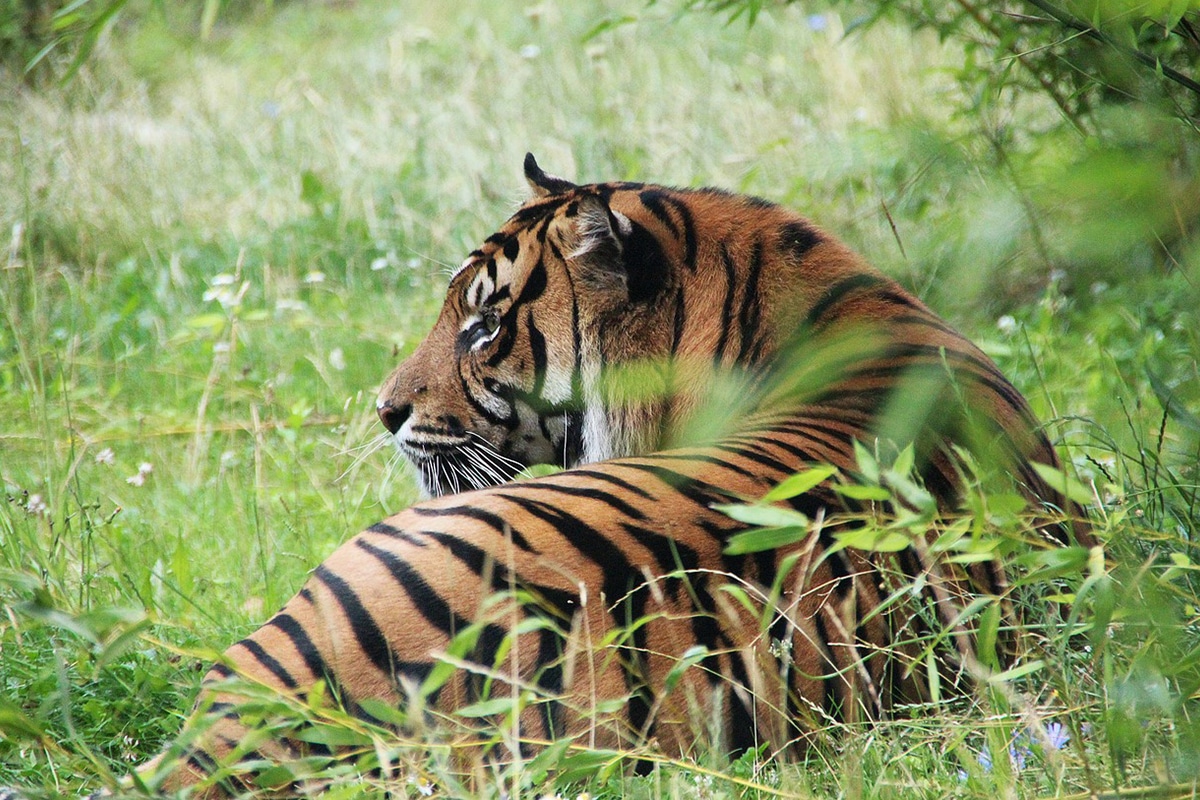Ranthambore Safari , Welcome to the breathtaking world of Ranthambore National Park, a sanctuary of wildest wonders and home to awe-inspiring tigers. Situated in the heart of Rajasthan, India, this remarkable national park offers a once-in-a-lifetime opportunity to witness the majestic beauty and raw power of these magnificent creatures up close and personal. A safari in Ranthambore National Park is a thrilling adventure that will leave you captivated by the sheer grandeur and grace of the Tigers that roam its sprawling landscapes.
Imagine embarking on a journey through dense forests, traversing rugged terrains, and immersing yourself in the untamed beauty of nature. As you venture deeper into the wilderness, the anticipation builds, and the possibility of a tiger sighting becomes more palpable. Ranthambore National Park presents a rare and enchanting experience, where you have the chance to observe the regal Tigers in their natural habitat, engaging in their daily routines and exhibiting their dominance over the vast expanse they call home.
Ranthambore is renowned for its thriving population of tigers, making it one of the best places in the world to encounter these magnificent creatures in their natural environment. The park is spread over an area of approximately 392 square kilometers, encompassing diverse landscapes ranging from thick forests to open meadows and rocky hills. This ecological diversity offers the perfect habitat for the Tigers, allowing them to roam freely and thrive.
A safari in Ranthambore National Park is an enthralling adventure that promises encounters with not only tigers but also a rich array of wildlife. The park is home to numerous other species, including leopards, sloth bears, sambar deer, nilgai, and a rich avian population. As you traverse the park in a specially designed safari vehicle, guided by experienced naturalists and trackers, the possibilities are endless. Every turn and corner may reveal a hidden jewel of the jungle, as you witness the untamed beauty of nature unfold before your eyes.
The allure of Ranthambore National Park goes beyond the thrill of tiger sightings. It is also a treasure trove of history and culture, with the majestic Ranthambore Fort standing as a testament to the rich legacy of the region. Dating back to the 10th century, the fort bears witness to the glory and grandeur of Rajputana architecture, offering a glimpse into the past. Exploring the fort is a journey through time, where ancient tales of valor and nobility come alive, adding a fascinating dimension to your safari experience.
Aside from its rich wildlife and historical significance, Ranthambore National Park is also known for its conservation efforts. The park plays a vital role in safeguarding the dwindling tiger population and preserving their natural habitat. Through sustainable tourism practices and community involvement, Ranthambore aims to ensure the long-term survival of these magnificent creatures and the delicate ecosystems they inhabit.
Embarking on a safari in Ranthambore National Park is an unforgettable experience that immerses you in the wonders of nature and the regal allure of tigers. Whether you are an avid wildlife enthusiast, a nature lover, or simply seeking a thrilling adventure, Ranthambore has something to offer everyone. So, pack your bags, grab your camera, and prepare to witness the majestic tigers in all their glory in this captivating sanctuary of untamed wilderness.
Contents
Ranthambore Safari Introduction

Ranthambore National Park, located in the state of Rajasthan, India, is a true haven for wildlife enthusiasts and nature lovers alike. Spanning over an impressive area of 392 square kilometers, this national park is renowned for its thriving populations of majestic tigers. The park’s captivating landscapes, rich biodiversity, and incredible tiger sightings make it one of the most popular destinations for a wildlife safari experience.
Covering a vast expanse of dense forests, open grasslands, and picturesque lakes, Ranthambore National Park provides a diverse and pristine habitat for a wide range of wildlife species. Along with the celebrated Bengal tigers, the park is home to various other animals, including leopards, sloth bears, jackals, deer, crocodiles, and many species of birds.
One of the primary attractions of Ranthambore National Park is its impressive tiger population. With around 60-70 tigers inhabiting the park, visitors have a remarkable opportunity to witness these magnificent creatures up close and in their natural habitat. The park’s comparatively high chances of tiger sightings add to the thrill and allure of a safari experience here.
The best way to explore the wonders of Ranthambore National Park is by embarking on a safari. The park offers both jeep and canter (open bus) safaris, allowing visitors to traverse the park’s rugged terrains in search of wildlife encounters. These safaris are guided by experienced naturalists who possess excellent knowledge of the park and its residents, providing visitors with insightful information about the flora and fauna they encounter along the way.
The safari experience in Ranthambore National Park is truly awe-inspiring. As visitors venture deeper into the park, they are greeted with breathtaking views of the landscape, from dense forests to vast grasslands, dotted with ancient ruins and picturesque lakes. The thrill of spotting a tiger in the wild is an unparalleled experience, where one can witness these magnificent creatures in their natural environment, displaying their raw power and beauty.
Apart from the tigers, Ranthambore National Park offers a multitude of other wildlife encounters. Leopards, known for their elusive nature, can be spotted stealthily moving through the thick foliage. Sloth bears, with their unique appearance, amble across the open grasslands in search of food. The park is also home to countless species of birds, making it a paradise for birdwatchers.
To cater to the needs of visitors, Ranthambore National Park has several safari zones, each offering a distinct ecosystem and wildlife experience. These zones are carefully managed to ensure sustainable tourism practices and minimize disturbance to the wildlife. This meticulous planning ensures that visitors have the best chance of encountering the park’s stunning residents while maintaining the ecological balance.
In conclusion, Ranthambore National Park offers a truly captivating and unforgettable safari experience. From the awe-inspiring tigers to the diverse range of wildlife and stunning landscapes, this national park provides a remarkable opportunity to witness nature’s wonders up close. Whether it’s a passion for wildlife or a desire for adventure, a safari in Ranthambore National Park promises an exhilarating journey through one of India’s most iconic natural habitats.
Exploring Ranthambore National Park
If you have a deep fascination for wildlife and a desire to witness the majestic tigers up close, then Ranthambore National Park is the perfect destination for you. Located in the state of Rajasthan, India, this national park is renowned for its rich biodiversity and is home to a thriving population of Royal Bengal tigers.
Discover the Enchanting Wilderness
Embarking on a safari in Ranthambore National Park is an immersive experience that allows you to delve into the enchanting wilderness and witness the raw beauty of nature. Spread across an area of approximately 1,334 square kilometers, the park is a sanctuary for a wide range of flora and fauna, making it a paradise for nature lovers and wildlife enthusiasts alike.
A Glimpse into Tiger Territory
One of the main attractions of Ranthambore National Park is its tiger population. With over 60 tigers roaming freely within its boundaries, the park provides ample opportunities to catch a glimpse of these elusive creatures. The tigers of Ranthambore are known for their majestic presence and captivating beauty, and spotting one in the wild is truly a thrilling experience.
Thriving Biodiversity
Beyond the tigers, Ranthambore National Park is teeming with an array of other wildlife species. Visitors can expect to encounter animals such as leopards, sloth bears, jackals, deer, and various species of birds. The park is also home to several crocodile-infested lakes, which serve as a vital water source for the animals during the scorching summers.
Safari Adventures
Exploring Ranthambore National Park is best done through the various safari options available. Jeep safaris and canter safaris are popular choices among visitors, allowing them to venture deep into the park and witness its diverse wildlife firsthand. These guided safaris are led by experienced naturalists who provide valuable insights into the flora, fauna, and conservation efforts within the park.
Historical Marvels
In addition to its natural wonders, Ranthambore National Park also boasts a rich historical heritage. The park derives its name from the ancient Ranthambore Fort, which stands majestically amidst the wilderness. This historic fort offers a glimpse into the region’s regal past and provides a picturesque backdrop to the park’s landscapes.
Conservation Efforts
Ranthambore National Park has played a significant role in tiger conservation in India. The park’s success in maintaining a healthy tiger population has made it a model for wildlife conservation efforts. Ongoing initiatives such as anti-poaching measures, habitat restoration, and community involvement have helped ensure the survival of these magnificent creatures.
A Paradisiacal Wildlife Experience
Ranthambore safari promises an unforgettable wildlife experience that combines adventure, natural beauty, and cultural insights. Whether you are a wildlife enthusiast, nature photographer, or simply someone seeking solace in the lap of nature, exploring this national park is sure to leave you spellbound and instill a deep appreciation for the wonders of the animal kingdom.
The Magnificent Tigers of Ranthambore

Ranthambore National Park is renowned for its population of magnificent tigers, making it a haven for wildlife enthusiasts and photographers from around the world. These majestic creatures are the main highlight of any safari experience in the park, captivating visitors with their beauty, power, and grace.
- A Haven for Tigers
- Ranthambore National Park is one of the best places in India to witness the thriving population of tigers. It is home to a significant number of these elusive big cats, providing a unique opportunity to observe their behavior and natural habitat up close.
- The park’s diverse terrain, which includes grasslands, dry deciduous forests, and rocky hills, offers the perfect setting for tigers to roam freely. This varied landscape not only provides them with abundant prey but also ensures their survival by offering ample cover for hunting and raising their young.
- Thrilling Tiger Safaris
- Embarking on a tiger safari in Ranthambore is an exhilarating adventure. Visitors have the chance to explore the park’s vast wilderness in specially designed open-top jeeps or canter vehicles accompanied by experienced naturalists and guides.
- The excitement builds as you venture deep into the park, keeping a close eye on the dense vegetation and water bodies where tigers are frequently spotted. With a bit of luck and patience, you may witness these incredible creatures prowling, resting, or even engaging in territorial disputes.
- The thrill of encountering a tiger in its natural habitat is something that cannot be matched. The powerful sight of a fully grown tiger, with its distinctive orange coat and black stripes, leaving visitors spellbound and in awe of its majestic presence.
- Behavior and Ecology
- Observing the behavior of tigers in the wild provides valuable insights into their social structure and ecological role. The park’s tigers display a range of fascinating behaviors, from marking their territory and hunting to raising their cubs.
- Tigers are territorial animals, and their scent markings are a common sight in the park. Witnessing these markings and tracking their movements can offer a glimpse into their complex social dynamics and interactions.
- Ranthambore’s tigers are skilled hunters, often relying on stealth and patience to catch their prey. Observing their hunting techniques, such as stalking and ambushing, is not only awe-inspiring but also highlights the crucial role they play in maintaining the delicate balance of the ecosystem.
- Conservation Efforts
- Ranthambore National Park has been at the forefront of tiger conservation efforts in India. The establishment of the park and strict conservation measures have helped in the recovery and protection of tigers and their habitat.
- Conservation initiatives in Ranthambore, such as anti-poaching patrols, community involvement, and habitat management, have contributed significantly to the growth of the tiger population. These efforts stand as a testament to the commitment to safeguarding these iconic creatures for future generations to admire and appreciate.
Visiting Ranthambore National Park offers a unique opportunity to witness the magnificence of tigers in their natural habitat. The combination of thrilling safaris, breathtaking sightings, and valuable insights into their behavior and conservation efforts makes it an unforgettable experience for wildlife enthusiasts and nature lovers alike.
Other Wildlife Encounters
While the majestic tigers are undoubtedly the star attraction of Ranthambore National Park, there is a plethora of other wildlife waiting to be discovered during your safari. The park is home to a rich and diverse ecosystem, making it a haven for nature lovers and wildlife enthusiasts alike. Here are some of the incredible creatures you may encounter during your visit:
- Leopards: Often referred to as the elusive ghosts of the forest, leopards can be spotted in Ranthambore if you’re lucky. Known for their stealth and agility, these magnificent cats hide among the trees and rocky outcrops. Keep a keen eye out for their distinctive spotted coat as you explore the park.
- Sloth bears: Ranthambore is also known for its population of sloth bears. These unique mammals are characterized by their shaggy black coats, distinctive white V-shaped markings, and long curved claws. With a bit of patience and luck, you may witness these solitary creatures foraging for food or cooling off in the water.
- Sambar deer: The park is home to a large population of Sambar deer, which are the largest deer species in Asia. These majestic animals with their impressive antlers can often be spotted grazing in the meadows or near water bodies. Look out for their reddish-brown coat and large ears as they navigate through the dense vegetation.
- Wild boars: Another commonly sighted animal in Ranthambore is the wild boar. These stout-bodied creatures are known for their bristly, dark hair and sharp tusks. As you venture deeper into the park, you may come across a group of wild boars searching for food or wallowing in muddy patches to beat the heat.
- Crocodiles: The lakes and water bodies in Ranthambore are teeming with crocodiles. Keep an eye out for their snouts poking out of the water or sunning themselves on the banks. These prehistoric creatures add an extra layer of excitement to your safari experience.
- Birdlife: Ranthambore is a birdwatcher’s paradise, boasting a rich diversity of avian species. From the vibrant plumage of kingfishers and peafowls to the soaring flight of eagles and vultures, the park is home to over 270 species of birds. Don’t forget to bring your binoculars and camera to capture the beauty of these feathered inhabitants.
It’s important to note that wildlife encounters in Ranthambore are unpredictable by nature. The park’s ecosystem is intricately intertwined, and every safari presents a unique opportunity to witness the wonders of nature. Keep an open mind, be patient, and let the magic of Ranthambore unfold before you as you explore its diverse habitats.
Conservation Efforts and Sustainability
Ranthambore National Park is not only a haven for wildlife enthusiasts and adventure seekers but also serves as a vital center for conservation efforts and sustainability. The park’s management and various organizations have implemented numerous measures to safeguard the rich biodiversity and ensure its long-term survival.
One of the key initiatives in place is the conservation and protection of the park’s flagship species – the majestic Bengal tigers. With a significant decline in tiger populations over the years, Ranthambore National Park has become one of the strongholds for tiger conservation in India. Rigorous monitoring, research, and anti-poaching activities are conducted to safeguard the tigers and their natural habitat. The park’s tiger population has shown a positive trend in recent years, indicating the success of these conservation efforts.
Apart from tigers, Ranthambore National Park is home to a diverse range of flora and fauna, including leopards, sloth bears, sambar deer, and many other species. The park’s management focuses on maintaining a delicate balance between wildlife conservation and sustainable tourism. Strict guidelines are followed to minimize the human impact on the park’s ecosystem. This includes enforcing limits on the number of vehicles and tourists allowed inside the park at any given time to minimize disturbance to the wildlife.
The park also engages in community-based conservation initiatives as a means to involve and benefit the local communities. These initiatives aim to create awareness about wildlife conservation among the local population and generate alternative livelihood opportunities that are aligned with conservation goals. By promoting sustainable practices and providing incentives for the local community to protect and preserve the park, Ranthambore National Park ensures a harmonious coexistence between humans and wildlife.
Moreover, efforts are made to restore and conserve the park’s natural habitats and ecosystems. This involves restoring water bodies, planting native vegetation, and preventing soil erosion to maintain the ecological balance necessary for the survival of its diverse wildlife population. Regular scientific studies and monitoring help in understanding the ecosystem dynamics and guide further conservation strategies.
The dedication and commitment of the park’s management, staff, and various conservation organizations have been crucial in the sustained success of Ranthambore National Park’s conservation efforts. Through their tireless work and collaboration, they have not only managed to protect the park’s unique wildlife but also create a model for sustainable wildlife tourism that can be replicated in other regions.
In conclusion, Ranthambore National Park stands out not only for its incredible wildlife and breathtaking safari experiences but also for its unwavering commitment to conservation efforts and sustainability. By implementing various initiatives aimed at protecting the park’s biodiversity, engaging local communities, and restoring natural habitats, Ranthambore National Park serves as a shining example of successful wildlife conservation and responsible tourism.


Comments